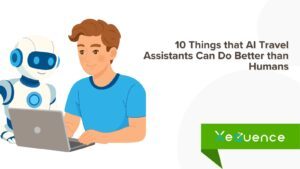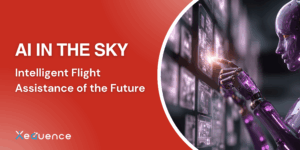- Home
- Artificial Intelligence
- From Rule-Based to Intelligent: The Evolution of OTA Chatbots
From Rule-Based to Intelligent: The Evolution of OTA Chatbots
- November 17, 2025
- XequenceAI
- Artificial Intelligence, Chatbot, Guest Experience

Next-Gen OTA Chatbots vs Regular Chatbots: What Sets Them Apart
Chatbots have become the workhorse of online travel agencies (OTAs) in a world where customers are used to receiving prompt customer service, tailored recommendations, and booking processes without any hustle and bustle. Customer interaction is, however, being redefined by the new wave of next-gen OTA chatbots. Instead of simple FAQs, they provide context-based, personalized, and omnichannel customer care. Yet, what is actually different about them as compared to regular chatbots? We should look into the differences between the currently developed travel bots and their older counterparts and how they are changing the travel industry.
The Change toward Intelligent Systems and a way of Rule-Based
The major distinction starts with intelligence. Common chatbots are usually rule based and use pre-coded scripts to respond to simple questions such as what is my booking status? or “What are your Money-back guarantees? They work on a pre-defined system of conversation- nice with simple chores, but when the questions posed by the user is different from pre defined system, the model fails to provide a great response.
Next-gen OTA chatbots on the contrary have artificial intelligence (AI) and natural language processing (NLP) to comprehend the context, tone, and intent. They do not merely react, they make sense. The bots today are able to cope with more complex situations, including multi-destination seat reservation and real-time adjustment of fares, as well as real-time adjustment of itinerary changes. Machine learning empowers them to become increasingly better at responding, the smarter and more intuitive responses both become better with time through learning.
Contextual Soap and touches and Personalization
A basic chatbot may understand or know what a traveler is requesting but not the identity of the traveler. Conversely, an OTA chatbot of the next generation recalls prior conversation and customizes replies based on this context. Such contextual memory enables it to comprehend the preferences e.g. travel class, frequent flyer status, and preferred destination.
To use it as an example, should a frequent flyer regularly reserve weekend flights between the city of New York and Paris, the chatbot will be able to suggest deals or hotel bundles in advance and make the recommendations to fit flyer tastes. Such one on one approach resembles a talented travel advisor, only much quicker, 24/7 and through more channels.
Predictive analytics-driven personalization increases customer satisfaction and loyalty and leads to conversions. This translates to a reduction in the number of carts and increase in the number of bookings in the world of OTAs.
Omnichannel Integration: Reaching Travellers Everywhere
Due to its flexibility, it enables travellers to communicate in any way and place they want. An illustration here is that a person may begin arranging a trip using an OTA platform, affirm it in a mobile application and subsequently plan a change using WhatsApp chat-support functionality-all without losing the history of conversation. What makes such modern bots groundbreaking is the possibility to cross-platform synchronization and user context memory.
The fast-paced travel sector proves to be one area where such an omnichannel functionality is particularly worthwhile due to its demand on real-time updates and frictionless service, no matter what device or channel the users use.
Active Participation and Anticipatory Emerging Capabilities
A significant promotion in next evaluated OTA chatbots is via the active nature of communication. These chatbots are able to know what customers need and counter with initiating beneficial interactions instead of waiting until the customer requests one. Suppose that you were getting a message before takeoff, they were informing you of the changes at the gate or baggage changes or of real-time advisories regarding weather issues and alternative booking options.
Such smart thinking puts chatbots at the top level of being reactionary devices rather than virtual travel advisors. They operate on predictive analytics and behavioural insights to make the customer experience more high-end, less stressful, and less prone to customers feeling unaccompanied throughout the journey.
Voice Enhancements and Visuals
Contemporary chatbots are not confined to text only communications anymore. The next-gen OTA bots that have visual AI and voice features are designed to ensure communication is more intuitive. Visual AI also allows uploads: a photo of a booking receipt or damaged luggage the user can just upload and provide the bot with said picture, which it can operate on.
In the meantime, chatbots with voice capabilities are assisting OTAs provide human-like service so that users can book flights or view their flight statuses without music using their voices. This ease of use is fitted with the current multi- device lifestyle that serves the kind-hearted travellers who attach importance to speed and convenience.
Conclusion
Next-gen OTA chatbots are not digital assistants but clever, proactive travel companions that can change the way the industry interacts with customers. They provide intentionality and efficiency never matched by traditional bots because they are based on high-end AI, situational knowledge, the availability of multiple channels, and the integration of data. There is a slow disappearance of the boundary between human service and AI as more travel platforms adopt this technology.
Simply put, a next-gen OTA chatbot will not only be an auto-bot but also be customized, anticipatory, or improved at every stage of the traveler experience. This development creates the vivid image of the future of digital travel: smart, networked, and infinitely adaptable.
Recent Posts
Newsletter
Get regular updates on data science, artificial intelligence, machine
You may also like

How AI Is Revolutionizing Flight Operations and Airline Economics

10 Things that AI Travel Assistants Can Do Better than Humans

The Economics of AI Flight Assistants: Lower Costs, Better Efficiency




